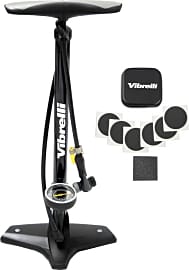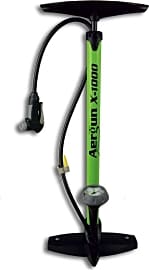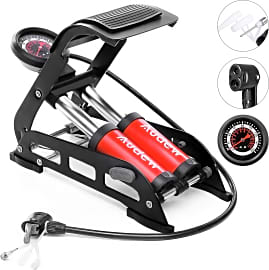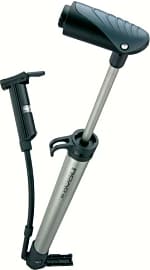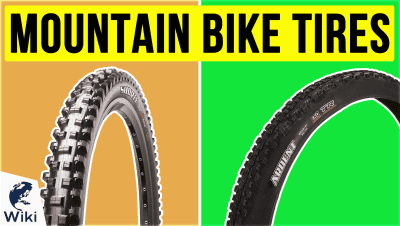The 10 Best Floor Pumps

This wiki has been updated 40 times since it was first published in June of 2015. If cycling is your preferred mode of transportation, you may need one of these durable floor pumps to help you maintain optimal tire pressure for a safe and smooth ride. Compatible with Presta and Schrader valves, our range of models pairs well with most road and mountain bikes. Some of our options come with attachments for blowing up mattresses, sports equipment, and pool toys as well. When users buy our independently chosen editorial picks, we may earn commissions to help fund the Wiki.
Editor's Notes
June 30, 2020:
When you spend a lot of money on a fancy mountain bike, you might not think much about the floor pump used to optimize its tires for various road conditions. We're here to tell you that the right floor pump can make all the difference, regardless of whether you're a casual cyclist, commuter, or racer. The ability to inflate those tires quickly, effortlessly, and with the proper amount of pressure will be key to ensuring a safe ride.
While a majority of our options accommodate Presta and Schrader valves, we've done our best to include versatile models that differentiate themselves in other ways. The affordable Vibrelli Performance, for example, includes a glueless puncture repair kit that comes in handy when you get a flat tire.
Another useful feature is the ability to hold a charge. For that reason, we've added the CyclingDeal GF-94T. Its lever-controlled reserve tank releases up to 260 PSI at one time, making it an ideal choice for inflating tubeless tires without the need for an air compressor.
If you need to make precise adjustments while on the trail, the pressure relief valves on the AerGun X-1000 and Lezyne Travel Drive make them dependable options, the former of which also comes with ball and bladder needles for inflating sports equipment and pool toys.
We've added the Audew Portable for its double-cylinder design, which delivers a flow rate of 35 liters per minute for fast inflation of car and automobile tires. Its frame also folds for convenient storage.
Both the Pro Bike Mini and Topeak Road Morph G can be easily clipped to a bike frame, the former of which is even small enough to fit in a backpack.
Despite its high price point, we feel the Silca SuperPista is still worthy of inclusion for its top-mounted gauge, programmable pressure alerts, and backlit digital display for easy viewing in dark places.
Special Honors
Enve Air Pressure Station If you have extra room in your garage or bike shop, you might want to consider the Enve Air Pressure Station. Although it requires access to both a power supply and air compressor, it is capable of achieving a pressure accuracy to within one-half percent of a PSI or BAR reading. Its digital interface, three pressure presets, and override function help ensure efficient seating of tubeless bicycle tires. Also included are a 15 foot coiled air hose, fittings, and an adjustable Presta valve air chuck. The station also provides a scannable NFC tag for mobile devices that links directly to Enve's tire pressure recommendation charts. Finally, it can be hardwired into mobile service trucks, vans, and trailers as well. enve.com
The Floor Pump: A Practical Standard For Rubber Inflation
For these reasons, you'll need a reliable floor pump to keep those tires fully inflated and ready for action.
Whether you experience the thrill of bike races or take leisurely rides around the city for exercise and recreation, the last thing you need to worry about is a flat tire ruining your chances of victory or causing an accident. For these reasons, you'll need a reliable floor pump to keep those tires fully inflated and ready for action.
Also known as a stand pump, the floor pump is a manually-operated air compressor that leverages piston-style action and positive displacement to inflate a bike tire. The device is typically equipped with: an air hose, creating a connection between itself and the tire; a sturdy base used to maintain stability on flat surfaces; a metal or plastic shaft connected to a handle at the top of the device; a plunger assembly at the bottom of the shaft, which creates and an airtight seal; and an integrated pressure gauge to monitor the air pressure inside the tire.
When the pump's handle and shaft are pulled in an upward motion, fresh air is sucked into the piston through an intake valve on the unit. When the handle is pushed down, air is compressed by the plunger, forced out of the piston and into the hose. Finally, the air flows through the hose and out of the pump's fill valve, which is connected to the inner-tube valve on a bike's tire. The repetition of up-and-down motion gradually inflates the tire.
Floor pumps attach to one of two types of inner-tube valves found on a bike's tire: Schrader and Presta. The Schrader valve is the same type of valve with which many car tires are equipped. This valve is short, relatively uniform in shape, and often sealed with a plastic cap. Most bicycles engineered before the 1980s used Schrader valves. By contrast, the Presta valve is longer, slimmer, and has a removable inner core. It requires twist-lock operation by the rider. Regardless of valve type, its purpose is to ensure that any air exiting the pump valve flows directly into a bike tire's corresponding intake valve without any loss of air pressure while in transit.
Pumping Up The Competition
Because floor pumps require manual operation, there are several things to keep in mind. One such consideration is the compatibility of the pump head. Depending on the type of bike you own, it's worth the extra expense to purchase a pump with a double-sided head that easily connects to both Schrader and Presta valves. Some pumps also include a special adapter for connecting to both valve types instead of using separately-dedicated ports for each valve. Whether you're a racer or you just ride your bike on a daily basis, invest in something with stainless steel parts instead of plastic to ensure its longevity over time.
Consider the size, placement, and accuracy of the pump's pressure gauge.
Think about the width and durability of the unit's base. A wide base provides stability on a variety of surfaces (e.g. cement or carpeting). Keep in mind that as you continue pumping air into your tires, the air pressure inside them also increases with each subsequent stroke. The less you have to fight with your pump and the wider the base, the easier it will be to maintain control.
Consider the size, placement, and accuracy of the pump's pressure gauge. A gauge with a small readout is easier to see when it's placed higher up on the pump body near the handle, which is more convenient than bending down to the pump's base to read it. Accuracy can also be verified using a digital tire gauge. Don't discount judging tire pressure by direct feel either. Depending on a tire's size, thickness, and the type of terrain it traverses, different levels of air pressure are acceptable. That said, you'll learn to recognize what constitutes a good level of air pressure by the way the tire feels after inflating it.
The comfort of the pump's handle is an important consideration because you'll be pushing down on it repeatedly. A handle molded to the shape of your palms will minimize excess fatigue, while also improving your stroke efficiency. We're not telling you to stand in your garage and compete with friends for the fastest tire inflation time. However, the level of resistance in the handle should be minimal with each downward stroke as you approach the tire's optimal air pressure.
Some floor pumps also come with on-board storage for extra components, such as needles and other attachments for inflating soccer balls and air mattresses, extending the device's functionality beyond just tire inflation.
A Brief History Of The Floor Pump
While no definite date exists for the arrival of the floor pump, common belief is that it appeared around the same time as Scotland native John Boyd Dunlop's invention of the first practical pneumatic rubber tire in 1887. Growing out of the need for something that could be used to inflate the tires on his son's tricycle, Dunlop's invention was an adaptation of the football pump, invented in the 1860s by Robert Lindon. This early floor pump consisted of a metal cylinder and rod running down the middle of the device, acting as a piston to suck fresh air in and force pressurized air out. The pump was also fitted with a valve for forcing air into a rubber tire.
The bicycle boom of the 1890s paved the way for many additional patents from inventors directing their attention to perfecting the pump's design. This time period also saw the birth of the automatic pump, which kept tires inflated while a bike was in motion.
Fast forward to modern times and the fundamental operation of the floor pump hasn't changed much. The majority of serious cyclists still depend on this device to properly maintain their equipment.


